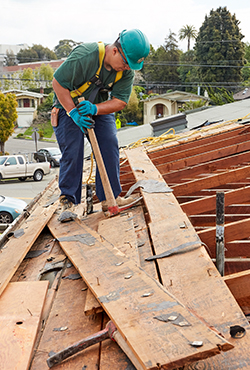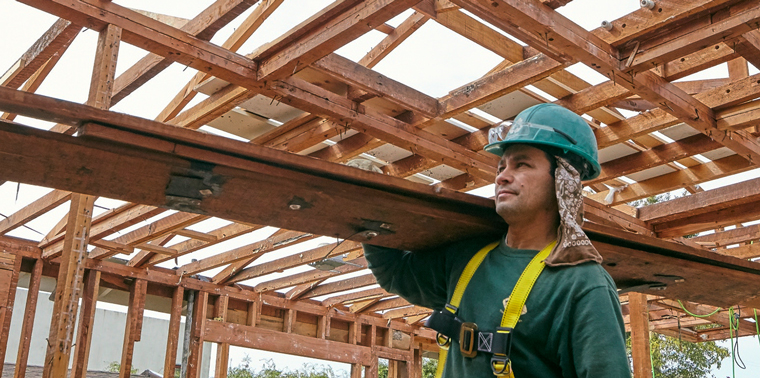October 9, 2018 — Just a few years after starting a non-profit reselling used building materials in the early 1990s, Ted Reiff’s organization, The ReUse People, hit a wall. “We couldn’t get enough materials to supply the demand,” he says. Despite tons of donated and salvaged doors, windows and structural beams coming in to his San Diego-based operation, the amount of people seeking cheap materials for homebuilding and renovation projects was overwhelming. “We were constantly getting cleared out every day.”
So Reiff got a demolition license. But unlike traditional demolition crews that simply knock buildings down with a backhoe, Reiff’s approach was to gradually disassemble the structures, carefully extracting saleable materials like a miner plucking gold nuggets from the ground. Reiff’s company became specialists in a relatively new concept known as deconstruction, dismantling homes piece by piece to preserve the abundant reusable components within.
Reiff was just trying to augment his supplies, but it didn’t take long to realize the broader benefits of what he was doing. Deconstructing a house meant not only that people could get affordable access to building materials, but also that those materials didn’t end up in a landfill — the end point for an estimated 500 million tons (454 million metric tons) of demolition waste in the U.S. annually. Every piece of material saved meant one fewer part that needed to be manufactured, cutting down the use of raw resources and the energy required to process them. And every home deconstructed created about twice as many jobs as a demolition.
Today, more than 20 years after Reiff first started reselling used building materials, deconstruction is slowly being recognized as the environmentally and economically sound solution to the wasteful problem of demolition waste.
“When we started, we were one of just a few people. Now there’s an association of us and there’s probably a hundred members,” Reiff says. His company alone conducts about 250 deconstructions a year.

Although deconstruction can offer benefits such as less waste and more jobs, it also costs more and takes longer, meaning demolition is still the mainstream option. Photo © iStockphoto.com/SergeyVButorin
But deconstruction is far from mainstream. “In terms of activity around the world, this is not something that’s taken root,” says Charles Kibert, professor of engineering and director of the Powell Center for Construction & Environment at the University of Florida. Deconstruction takes longer than demolition and can cost twice as much. Though homeowners can offset these costs through tax deductible donations of salvaged building materials to organizations like Reiff’s, the extra time and effort required can be a deterrent, Kibert says.
A bigger barrier, though, is the way buildings are built, he says. Especially in the post World War II era, cheaper materials and chemical-based glues and fire retardants have rendered many of a building’s components either worthless or too costly to process. “What we’re suffering from in the building industry is not necessarily planned obsolescence, it’s just garbage,” says Kent Wilson, an R&D Design Specialist at the University of California, Berkeley’s Jacobs Institute for Design Innovation. “We’re talking about baseboards that are made out of fiberboard and plastics that are just not reusable.”
Many buildings, particularly those built before the 1940s, are full of valuable resources. And yet many of them are still going to waste, especially in struggling economies littered with abandoned homes.
This is the case in Milwaukee. “You’ve got three- and four-hundred-year-old white pine going to the landfill,” says Robert Bauman, an alderman on the city’s common council. “It’s rather tragic, actually.”
Bauman says the city has nearly 200 abandoned homes in need of immediate demolition and perhaps thousands more facing imminent raze orders, so he proposed legislation to deconstruct any home on the list built before 1930, thereby pulling out this old-growth lumber and diverting reusable resources from the dumps. And, in an economically struggling inner city, deconstruction offered the added bonus of providing jobs. “If we can put ex-offenders to work doing legitimate, useful things for a family-supporting wage and getting them on a path to regular employment in the construction industry, everybody saw the benefit of that,” he says. The ordinance passed unanimously and was enacted earlier this year.

In addition to keeping materials out of landfills and cutting down on the use of raw materials, deconstruction also creates job opportunities that aren’t available with demolition. Photo courtesy of The ReUse People of America, Inc.
“The thing about reusing materials is it’s all labor,” says Pam Howland, founder of Old Window Workshop, a restoration business in Springfield, Massachusetts. Old Window Workshop’s mission is to provide jobs to women, training them to rebuild and restore antique windows that are pulled out of buildings undergoing renovation or deconstruction. For Howland, the goal is partly to reduce waste, but also to help low income women develop new skills. “This is Springfield. We’re located in the lowest income neighborhood in the state,” Howland says. “It’s very easy to find folks who need work in the middle of this city, and every city, really.”
Finding a steady stream of projects, though, has been challenging. Howland says a project to replace hundreds of windows on Springfield’s city hall has stalled for months. And even though it can be cheaper to restore existing windows on older buildings, Howland says many people still opt for the faster solution of buying new windows and sending the old ones to the dump.
Despite deconstruction’s environmental and social benefits, many barriers are still holding it back — from demand to cost to arcane stipulations in building codes. In Milwaukee, nearly a year since the deconstruction ordinance was enacted, only a handful of private buildings have gone through the process, according to Bauman. Of the many buildings on the city’s rolls, he says none have been deconstructed.
“As is often the case with these sustainability initiatives and any other out-of-the-box ideas, you run into a plethora of bureaucratic opposition,” says Bauman. Because of specific rules for dealing with asbestos and other contaminants like lead paint, the deconstruction of publicly owned buildings has turned out to be about twice as expensive as privately-owned homes, according to Bauman. “If we don’t get the prices reduced then the program probably falls apart and we go back to the old way of just throwing stuff in a landfill,” he says.
Progress has been slow. “I’ve been at this now 25 years,” says Reiff of The ReUse People. “If I knew it was going to be this tough, I don’t know whether I would have started it or not.”
But there are signs of hope. Reiff’s company has recently expanded into Canada. Vancouver was one of the first cities to enact a deconstruction ordinance, and Reiff expects to deconstruct about 40 homes there in its first year. In Portland, Oregon, which preceded Milwaukee in requiring some deconstruction, about 80 homes were permitted for deconstruction in the first year since its ordinance was enacted, diverting an estimated 2,500 tons (2,200 metric tons) of material from the landfill.
Ensia shares solutions-focused stories free of charge through our online magazine and partner media. That means audiences around the world have ready access to stories that can — and do — help them shape a better future. If you value our work, please show your support today.
Yes, I'll support Ensia!

We may have reached a point where people are slowly realizing this because they can no longer afford a house, even a cheap one. On a building site I can now point to any material and tell you how much it will cost to replace it, and it is always more profitable to reuse, especially if it can be done on site so no transportation cost is added.
Of course, no one wants a job doing building, let alone doing recycling, so this change will still not come very quickly.
Part of the reason for the cost reduction was that, at the time, salvage yards were willing to pay little or nothing for the materials they accepted; and may have even charged a fee for receiving the materials. Why? Because there was such a glut of such materials that reselling them was no longer profitable.
How times change.